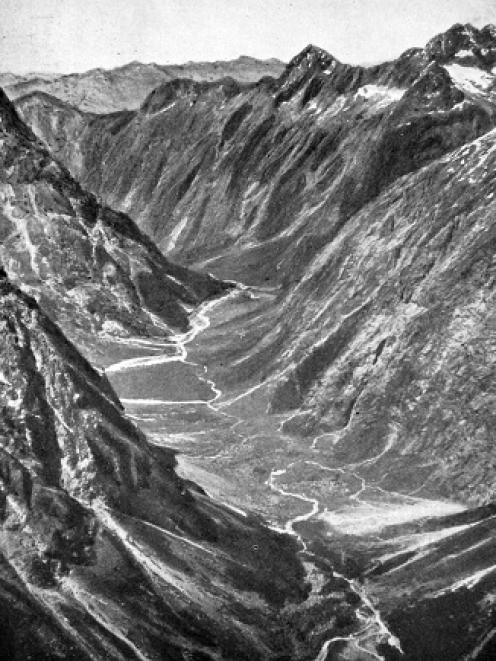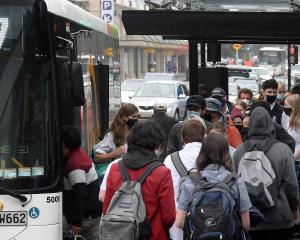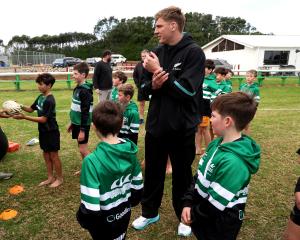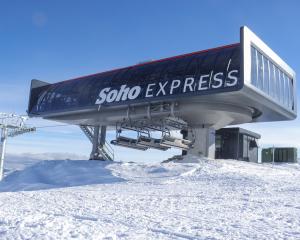
Looking down the Hollyford Valley, Fiordland, from the summit of Mt Lippe. — Otago Witness, 29.4.1924
This hut is the Rome to which all roads, or rather tracks, lead. It is the terminus of the track form Paradise up the Routeburn Valley and over the Harris saddle. It is the jumping-off place to the Lower Hollyford Valley and to Martin’s Bay, to the Upper Hollyford Valley, and to the track to Lake Te Anau. It is usually, then, if not the base of operations of any party in the district, at least an important link in their connection with civilisation and a necessary stopping-place en route. The initial procedure in a lengthy expedition to the Hollyford is therefore, to pack one’s stores to the Howden Hut. The only track up which pack-horses can be taken to Lake Howden is that which loads from Elfin Bay per the Greenstone Valley. Those readers who have picnicked at Rere Lake will know at least the first portion of the route: a short half-hour’s walk from Elfin Bay lies a pretty picnicking spot, Rere Lake, a small but extremely beautiful sheet of water in a wonderful setting of bush and mountain. From Rere Lake a well-defined track leads down to the right bank of the Greenstone River, now spanned by a strong bridge at the spot where the truck crosses it. From the bridge the track follows the left bank of the river, but high above it, quite pleasant and easy walking through spectacular bush. About three hours after leaving Rere Lake the track leads one out of the bush to the open flats in the river valley. The track skirts the shore of Lake Mackellar for three miles or so and then passes into th bush around Lake Howden. Another half hour and you can hail the Howden Hut. Owing to the accessibility of the Upper Hollyford Valley, this track deserves description. It is the highway into a natural park of mountain scenery passing all description.
Galloway’s dairy potential
For the past two years on a farm area of some 100 acres at Galloway, in Central Otago, the Department of Agriculture has been carrying out experimental work in determining the best methods of applying irrigation for pasture establishment and maintenance and for producing fodder crops for dairy cows. The land when first occupied was a bare expanse, practically without any growth upon it of any kind except a few struggling weeds. Now, as a result of irrigation, combined with up-to-date farming methods, a variety of fodder crops has been grown. The practical information gained regarding the various irrigation methods which have been tried out and the range of fodder crops experimented with now warrants establishing a demonstration
dairy farm. As a result of a conference between the Minister of Agriculture and the Minister of Public Works plans for the necessary buildings, yards etc are being prepared so that the demonstration work can go ahead with as little delay as possible. "The activities of the department on this area," says the Hon W. Nosworthy, "have been specially directed to experimental work bearing on dairying on irrigated land, and on fat lamb production on both irrigated and non-irrigated lands, and given good settlers of the right type who are not afraid of hard work there should be a certainty of a very great increase of production in Central Otago."
Site for Woodhaugh club
The reserves committee will report to the meeting of the City Council to be held next week that it has considered proposals from a proposed bowling and croquet club in the north end for the construction of greens in a portion of the Woodhaugh Gardens. The committee has approved of the proposal and has agreed that the Reserves Department should undertake the work
on the condition that the club pays the actual cost incurred, £500. This the club has agreed to do. The committee will recommend that the proposals be approved by the council and that authority be granted to carry out the construction work on behalf of the club as outlined. The yearly charge for the use of the area will be made when the work is completed. — ODT, 8.3.1924











